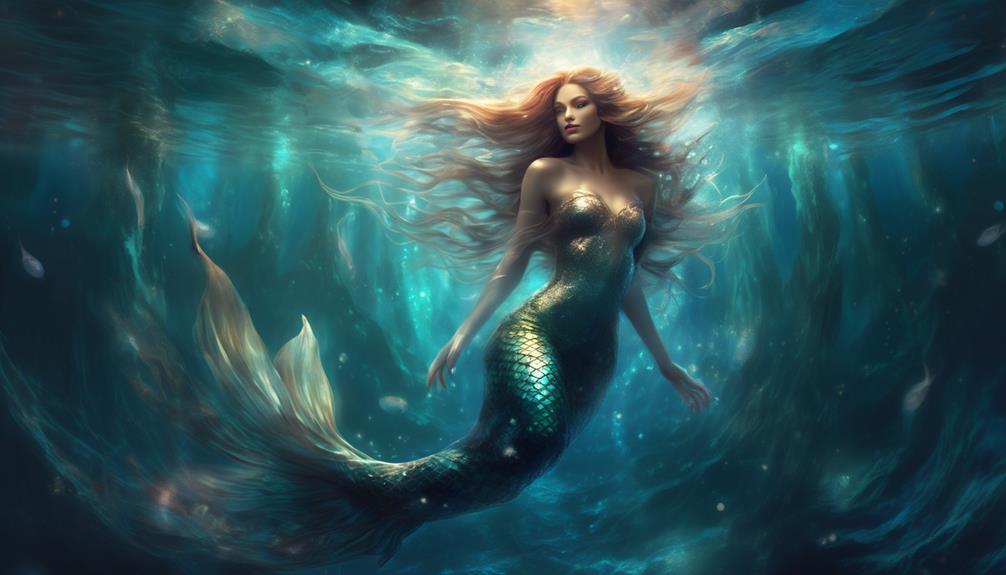In Greek mythology, the tale of the mermaid, Thessalonike, daughter of a sea god, is a well-known example of mermaid metamorphosis.
The ancient myths surrounding mermaids and their mystical transformation tales have captivated cultures around the world for centuries.
From stories of mermaids shifting between human and aquatic forms to their representation in art and literature, the allure of these enigmatic beings and their ability to undergo metamorphosis continues to intrigue.
What is the significance of these transformation narratives, and what do they reveal about human beliefs and desires?
Key Takeaways
- Mermaid myths have origins in ancient civilizations such as the Greeks, Babylonians, and Assyrians.
- Mermaid transformations in Greek mythology often involve divine intervention and showcase the theme of transformation as a consequence.
- Mermaid folklore across cultures includes tales of shapeshifting abilities, adding unique twists to their stories.
- Mermaid transmutation tales in literature and art symbolize adaptation, fluidity, and the exploration of identity.
The Origin of Mermaid Metamorphosis Myths
The ancient origins of mermaid metamorphosis myths remain shrouded in mystery and fascination. Historical evidence suggests that the concept of mermaids dates back to ancient civilizations such as the Greeks, Babylonians, and Assyrians. These cultures often depicted hybrid creatures with human upper bodies and fish-like tails, giving rise to the idea of mermaids.
The roots of mermaid myths can also be traced to the Sirens of Greek mythology, who lured sailors to their doom with their enchanting voices. Scientific explanations for these myths often point to sightings of manatees, dugongs, or other marine animals as potential sources of inspiration. These creatures, with their human-like features and aquatic habitats, may have sparked the imagination of sailors and coastal communities, leading to tales of mermaids.
While historical evidence and scientific explanations shed light on the possible origins of mermaid myths, the allure and enduring appeal of these enchanting creatures continue to capture the imagination of people around the world.
Mermaid Transformations in Greek Mythology
Mermaid metamorphosis myths in Greek mythology intertwine ancient tales of sirens with enchanting transformations that captivate the imagination. Greek folklore is rich with stories of mythical creatures, and mermaid folklore is no exception. Among the oceanic legends of the Greeks, mermaids are often depicted as enchanting beings with the ability to transform.
One of the most famous stories in Greek mythology involving mermaid transformation is that of the sirens. Originally portrayed as half-bird, half-woman creatures, the sirens were later depicted as mermaid-like beings. According to mythology, the sirens were cursed and transformed into half-woman, half-bird creatures by the goddess Demeter. This transformation was a punishment for failing to prevent the abduction of Demeter's daughter, Persephone. The tale of the sirens showcases the theme of transformation as a consequence of divine intervention.
Greek mythology is replete with such stories, where mermaids and other mythical creatures undergo remarkable transformations, adding to the allure of these ancient tales.
Shapeshifting Mermaids in Folklore Around the World
Across diverse cultures around the world, tales of shapeshifting mermaids have captured the imaginations of people for centuries. Mermaid folklore is rich with stories of these mystical beings possessing the ability to transform their appearances.
In some cultures, mermaids are believed to be able to take on human form at will, allowing them to interact with and even fall in love with humans. In other traditions, mermaids are said to possess the ability to shapeshift into various sea creatures, such as seals or fish, enabling them to navigate their underwater realms with ease.
The cultural variations in shapeshifting mermaid folklore are fascinating, with each tradition adding its own unique twist to the tales of these enchanting beings. From the selkies of Celtic folklore to the ningyo of Japanese mythology, shapeshifting mermaids continue to captivate the hearts and minds of people around the world, serving as a testament to the enduring allure of these captivating creatures.
Mermaid Transmutation Tales in Literature and Art
Shapeshifting mermaids have been a popular subject in various forms of art and literature, with their mystical transformations captivating audiences across cultures and time periods. Mermaid transmutation tales have been prevalent in literature and art, often portraying the mermaid's ability to change forms as a reflection of deeper symbolism.
In literature, mermaids are often depicted as beings who undergo metamorphosis to navigate the complexities of human emotions and experiences, symbolizing themes of adaptation, fluidity, and the duality of nature. These tales explore the mermaid's transformation as a metaphor for personal growth, change, and the exploration of identity.
Artistic representations of mermaid transmutation tales often showcase the enchanting and ethereal nature of these beings, emphasizing their ability to shift between different forms and realms. From ancient cave paintings to Renaissance masterpieces and contemporary works, mermaids have been depicted undergoing transmutation, symbolizing the ever-changing and enigmatic aspects of existence.
Artists often use mermaid symbolism to explore themes of transformation, mystery, and the interconnectedness of human and natural worlds, creating visually stunning and thought-provoking pieces that continue to fascinate audiences.
The Symbolism of Mermaid Metamorphosis
The mystical transformation of mermaids holds profound symbolism, reflecting themes of adaptation, fluidity, and the duality of nature in both literature and art.
The metamorphosis of mermaids in folklore and mythology is rich with symbolism and interpretation. In many stories, the mermaid's transformation from sea creature to human form represents the idea of adaptability and the ability to navigate different environments. This metamorphosis is often seen as a reflection of the fluidity of identity and the capacity for change. Additionally, the duality of the mermaid's nature, being both of the sea and of the land, symbolizes the coexistence of contrasting elements within individuals.
In art, the symbolism of mermaid metamorphosis is often depicted through visual representations of the transformation process, highlighting the intricate and transformative nature of the mermaid's existence. The interpretation of this symbolism varies across different cultures and time periods, offering a diverse range of meanings associated with the mermaid's metamorphosis.
Frequently Asked Questions
Are There Any Modern-Day Sightings or Encounters With Mermaids?
Modern-day sightings or encounters with mermaids are often attributed to folklore and mythology rather than reality. However, some individuals claim to have seen mythical creatures resembling mermaids, but these accounts remain unverified.
What Scientific Explanations Are There for the Origins of Mermaid Transformation Myths?
Scientific explanations for the origins of mermaid transformation myths often stem from folklore origins and evolutionary theories. These mythical creatures may have been inspired by misinterpretations of manatees, dugongs, or other marine animals, which contributed to the enduring mermaid legends.
How Do Different Cultures Around the World Interpret Mermaid Transformations?
Different cultures around the world interpret mermaid transformations in diverse ways, reflecting their unique beliefs and traditions. These interpretations hold deep cultural significance, often symbolizing themes such as love, sacrifice, and the lure of the sea.
Can Mermaid Transformation Tales Be Found in Contemporary Literature and Art?
Artistic interpretations of mythical creatures like mermaids can be found in contemporary literature and art. Folklore adaptations continue to inspire new stories and visual representations, showcasing the enduring fascination with mermaid transformation tales.
What Do Mermaid Transformations Symbolize in Different Cultures and Belief Systems?
Mermaid transformations hold symbolic meaning in various cultures, reflecting themes of change, duality, and freedom. Cultural interpretations vary, with some seeing it as a metaphor for adaptation, while others view it as a representation of the human connection to the sea.

